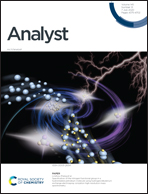A cost-effective fluorescence biosensor for cocaine based on a “mix-and-detect” strategy†
Abstract
The efficient detection of illicit drugs such as cocaine continues to be important for the fight against drug trafficking. Herein, we report a one-step method for rapid and specific cocaine detection. The method is based on our finding that small-molecule Thioflavin T (ThT) can act as a fluorescence indicator, which can be bonded with the anti-cocaine aptamer (MNS-4.1) to generate an enhanced fluorescence signal. More interestingly, upon cocaine binding, the intercalated ThT can be replaced, causing a drastic fluorescence reduction. We further optimized the sequence of MNS-4.1 and a new anti-cocaine aptamer (coc.ap2-GC) was obtained. This aptamer showed a higher affinity to both ligands, which increased the ThT binding fluorescence intensity and showed the highest quenching efficiency. Based on the fluorescence change induced by competitive binding, cocaine detection could be accomplished by a “mix-and-detect” strategy within seconds. Such a label-free method exhibits high sensitivity to cocaine with a low detection limit of 250 nM. Moreover, the practical sample analysis (2.5% human urine and saliva) also exhibits good precision and high sensitivity.



 Please wait while we load your content...
Please wait while we load your content...